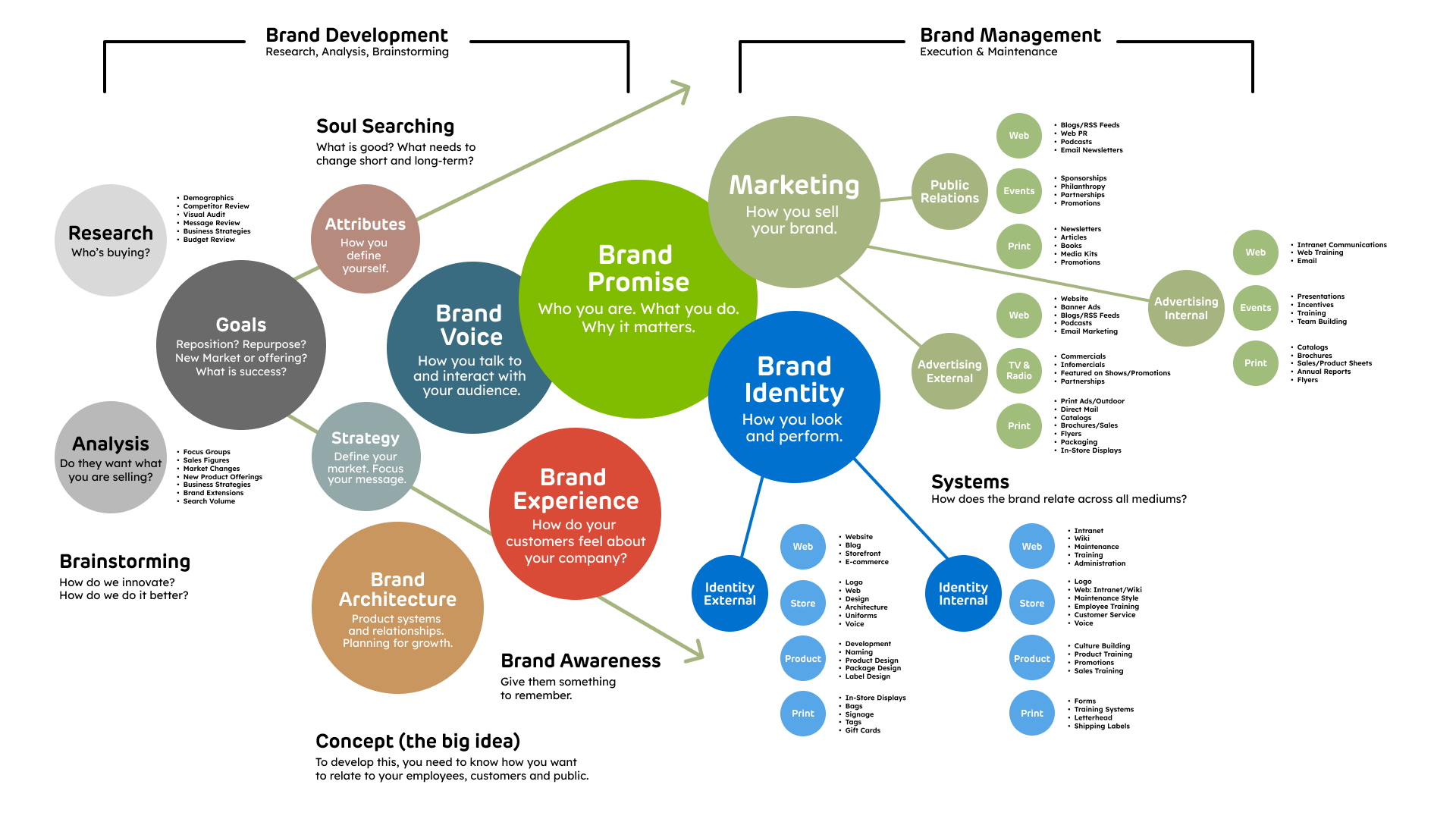As the editor-in-chief of Forbes Media, Steve Forbes once said, “Your brand is the single most important investment you can make in your business.” But something we’ve realized with many business owners is that they tend to create a logo, but put off investing into building a brand identity once the business is running smoothly.
Why do branding and design so often fall by the wayside?
It can become an afterthought, one of those unchecked boxes that keeps falling further down the to-do list.
Since your company is both a business and a brand, investing in a visual identity makes sense if you believe in your product.

Brands like GE, Microsoft or Adobe often evoke feelings and inspire confidence. It took much more than a single campaign to build these brands. It took years for those brands to build their identity and become how you experience them today. In addition to telling a company’s story, visual identity builds customer affinity and increases revenue. Lackluster messaging and disjointed graphics can confuse customers.
Branding relies heavily on visual identity, so it’s crucial to know what makes up an identity and how to create one.
How Do You Define Visual Identity?
Visual identity consists of all the graphics and images that make up your brand’s visual aspect. But we’re not just talking about colors or your logo. Visual identity is much more than how your business looks on video, the illustrations you share and incorporate into your messaging, and even how you photograph. As a result, it encompasses a wide range of aspects within your company. The strategic aspect of building and assessing your brand’s visual identity is an essential part of working with a company like ours that specializes in brand development and integrated marketing.
It’s More Than Just a Brand
First of all, it’s important for business owners to realize that branding is not the same as visual identity design.
Brand identity refers to the more “internal aspects” of a brand, such as its mission, voice and personality. A company’s visual identity is what identifies it “physically,” such as its logo design, brand colors and typography. When you’re aware of a company’s brand, that’s when equity comes into play. This is what informs customers’ perceptions of you as an entity: what you stand for and a deeper understanding of your mission. Your reputation enters the room before you do.
Investing in Your Brand: What Does It Mean?
Take a second and picture a party with people who stand out, have charming personalities and are 100% the center of attention. Everyone else at the party feels seen, valued and emotionally connected to them because of their magnetic personality. A well-curated visual identity makes your brand stand out in a similar fashion. You can also project consistency and maturity with a set of design assets and brand guidelines in the age of multiple digital channels. They form a cohesive identity when used across social media, print media, emails and outdoors.
Why Do Visual Identities Matter?
So if your reputation is what comes first, then why do visual identities matter so much? What’s the real purpose here?
As we all know, there’s a ton of competition in the world. Whether it’s individuals on social media or large corporations, there are a lot of people fighting for the same space. In a competitive market, it’s crucial to stand out. The marketplace really benefits from having a visual representation of who you are. Colors convey a lot about your brand through the choices or representations you make. When that brand walks into a room, it can communicate a lot visually.
The key thing about visual identity is that it helps identify you in a marketplace. And with the way the human brain works and processes information, it’s constantly looking for something that it can recognize immediately. Your brain automatically starts to bring in all these other elements the faster you identify a company or a brand.
Narrating a Visual Story
The idea of branding is to look beyond the product and tell a story that evokes the right emotion. Using packaging, product photos, social media posts and website graphics to tell a good story turns admirers into loyal customers. In a visual identity, the name, logo and visuals trigger a combination of physical and emotional responses that evoke feelings about how your company wants people to feel.
Visual Identities Are a Non-Negotiable, and Here’s Why
Planning, executing and maintaining your visual identity is a worthwhile investment of your time, money and effort. There are a few reasons why developing a visual brand identity can help your business thrive:
The “Sea of Sameness” Can Be Avoided With It
To stand out in the marketplace, you need to be remembered, but there is a “sea of sameness” in almost every category. Building awareness and recognition begins with a simple, clear and recognizable brand identity that can differentiate you from your competitors!
The Positioning of the Brand Is Communicated Through It
Besides attracting attention at the point of sale, visual identity plays a significant role in most categories. A company’s art and copy, as well as its functionality, usability and brand role, play an essential part in communicating a brand’s positioning.
Real stories have been at the forefront of the conversation when it comes to brand building for a while now. The story of a successful brand needs to be told, and it needs to stay relevant as the world changes. Putting branded storytelling into action has many layers and channels, but visual identity is often overlooked in terms of its impact and importance in the brand’s storytelling, despite its role in consumer engagement, purchase intent and product usage. It’s the first impression of the brand, and great designers know how to tell stories in the shortest amount of time.
Marty Neumeier says trust matters more than features and benefits when it comes to determining which product consumers buy in “The Brand Gap.” Brands are shortcuts or gut feelings. Rather than analyzing brands rationally, we engage with them emotionally. Hence, everyone creates their own brand in their heads — and only when enough people agree on the same image do we have a real brand.
Your Brand’s Visual Elements Establish a Consistent Personality
Your brand will be more visible and recognized with this strategy. Visual identity designs that are well organized lay a concrete foundation. Salesforce is an excellent example of this. A single color (blue) and the shape of a cloud makes it easily identifiable to customers.
A Brand’s Visual Identity Helps Shape Its Personality, Which Builds Customer Perception
Apple’s brand in the business world is synonymous with high-end or flashier products, often used in creative services or other intensive applications, while the brand perception of Microsoft feels more utilitarian in nature. Simply seeing the iconic Windows or Apple brand immediately tells the user how they will need to interact with products. It is extremely expensive and time-consuming to create this type of broad user knowledge of your brand, but you can find ways to bring that level of brand engagement to your direct customer base.
Visuals help you position your brand in the market once you know the audience you want to reach. Essentially, it inspires your customers. Your brand’s visual elements, such as logos and websites, are its face. Your potential audience can trust your brand if you have a strong brand identity. Through it, you can find new customers and delight existing ones with your products and services, which reinforces the beliefs of your company. In addition to that, it gives you a unique edge over your competitors by injecting your personality into the mix. You assure your customers that your relationships come before sales — something similar to a family.
Brand Design Influences Business Profitability
All businesses and organizations want leads and conversions. There are two ways to make money from a sale: either to collect funds or create a lifelong advocate for your brand. It is your brand’s visual media that attract and connect with your audience, evoke reactions and motivate them to act.
Brand Equity Is Increased and Strengthened by Visual Branding
You must make sure that your brand name is among the top three choices of a customer in an industry in order to be successful in that category. For example, in many of our minds, accounting software is associated with QuickBooks or NetSuite. Find out where you want to be in your particular industry niche.
You Get To Choose Your Customers
Creating an ideal persona is the key to a successful brand identity and design project. A brand identity allows you to target customers whose desires align with your company’s values, goals and culture rather than trying to appeal to a broader audience.
You can craft messages that target your ideal customers based on these clearly defined customer personas. With this approach, you will lay the foundation for a loyal customer base that will later become brand advocates.
What Are Some Ways Visuals Can Boost Social Brand Equity?
Brand equity is such a key factor when it comes to creating compelling visuals. You have to keep your customers in mind with every decision you make so that they have a good relationship with your brand. Here are some benefits:
Raise Brand Awareness
In order to make sure your customers remember your brand, what’s the number-one way to do it? Visual content, of course! According to research, 65% of the general population are visual learners, which means they need to see information to retain it. Written and verbal communication do not have the same speed as visual communication, so it’s much more accessible to reach your audience through visual content. A branded video was also shared with friends by 83% of customers.
Visual content ultimately improves brand equity by increasing brand awareness. In order for it to stand the test of time, there must be great detail and planning. A brand’s awareness gives you an edge over your competitors when your customers are choosing between brands. Maintaining consistency across all platforms makes it easier for your brand to be recognized.
Traffic Increase on Your Website
By the end of 2021, videos made up 82% of internet traffic worldwide, according to the Cisco Visual Networking Index. You can get more traffic to your website through video production, but it is expensive. The click-through rate for videos is 41% higher than plain text. Here’s a less expensive alternative if creating extensive videos is outside the budget.
Engage viewers on different sites with short videos. The goal is to drive traffic to your site, so this might seem counterintuitive. However, if your brand is present elsewhere, you might get more customers to come to your website because they want to know more about you. Remember to include the right keywords in your videos if you want them to show up in search results.
Visual Identity Is the Gateway To Increasing Brand Equity
Design has the power to connect with people, stir emotions and transport them. With the same sensibility in your brand’s visual identity, the sky’s the limit for your business. As specialists in integrated B2B marketing solutions and brand development, our team places the focus on customer engagement for value creation.
At S.O. CREATIVE, we focus on helping you develop and manage a dynamic, magnetic brand that attracts your ideal customers and drives growth.

